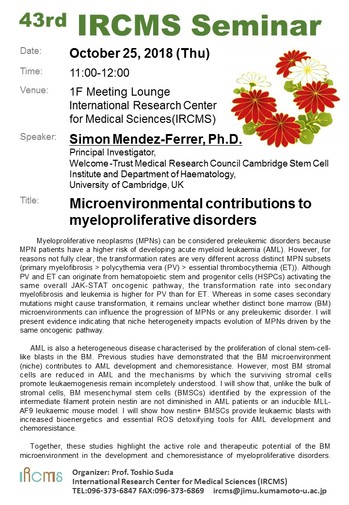- HOME
- IRCMS Seminars
- [Oct 25] 43rd IRCMS Seminar
IRCMS Seminars
[Oct 25] 43rd IRCMS Seminar
September 10 2018
We would like to inform you that the 43rd IRCMS Seminar has been scheduled as below. We would be pleased to see many of you participating in the seminar.
Date : October 25, 2018 (Thu)
Time : 11:00 - 12:00
Venue : 1F Meeting Lounge, International Research Center for Medical Sciences (IRCMS)
Speaker : Simon Mendez-Ferrer, Ph.D.
Principal Investigator,
Welcome -Trust Medical Research Council Cambridge Stem Cell Institute
and Department of Haematology, University of Cambridge, UK
Title : Microenvironmental contributions to myeloproliferative disorders
Abstract:
Myeloproliferative neoplasms (MPNs) can be considered preleukemic disorders because MPN patients have a higher risk of developing acute myeloid leukaemia (AML). However, for reasons not fully clear, the transformation rates are very different across distinct MPN subsets (primary myelofibrosis > polycythemia vera (PV) > essential thrombocythemia (ET)). Although PV and ET can originate from hematopoietic stem and progenitor cells (HSPCs) activating the same overall JAK-STAT oncogenic pathway, the transformation rate into secondary myelofibrosis and leukemia is higher for PV than for ET. Whereas in some cases secondary mutations might cause transformation, it remains unclear whether distinct bone marrow (BM) microenvironments can influence the progression of MPNs or any preleukemic disorder. I will present evidence indicating that niche heterogeneity impacts evolution of MPNs driven by the same oncogenic pathway.
AML is also a heterogeneous disease characterised by the proliferation of clonal stem-cell-like blasts in the BM. Previous studies have demonstrated that the BM microenvironment (niche) contributes to AML development and chemoresistance. However, most BM stromal cells are reduced in AML and the mechanisms by which the surviving stromal cells promote leukaemogenesis remain incompletely understood. I will show that, unlike the bulk of stromal cells, BM mesenchymal stem cells (BMSCs) identified by the expression of the intermediate filament protein nestin are not diminished in AML patients or an inducible MLL-AF9 leukaemic mouse model. I will show how nestin+ BMSCs provide leukaemic blasts with increased bioenergetics and essential ROS detoxifying tools for AML development and chemoresistance.
Together, these studies highlight the active role and therapeutic potential of the BM microenvironment in the development and chemoresistance of myeloproliferative disorders.
